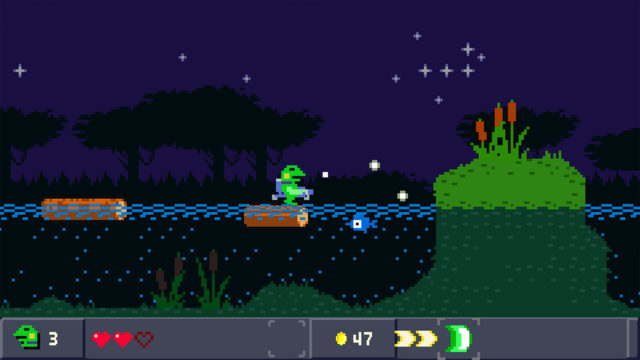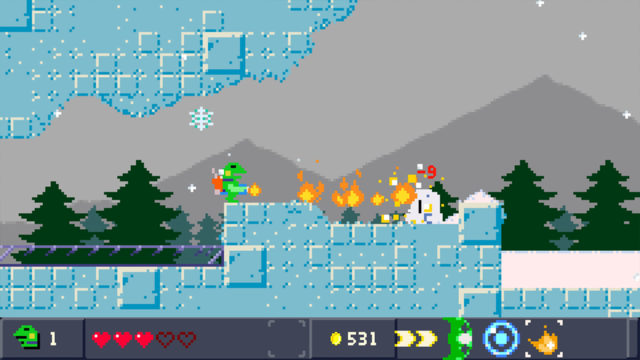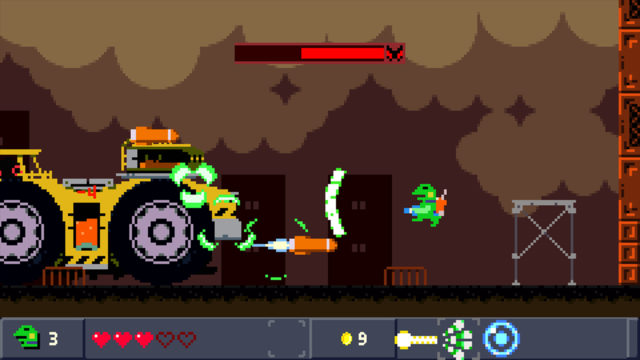Creative pixel art style; tight, precise shooting mechanics and platforming; killer soundtrack; lots of replay value; hilarious writing and cast
Even with three modes in tow, it's a little too short; difficulty is mitigated by the upgrade system, but some might still be too overwhelmed by it
Daisuke “Pixel” Amaya might not be a household name, but his signature creation Cave Story will likely ring a bell. That game, which released on PC way back in 2004, has been ported to countless other formats, including Nintendo Switch. It was subsequently followed up by the short-but-sweet Ikachan and the delightful Kero Blaster, with the latter being our focus here today. Kero is a love letter to the run-and-gun thrillers of yore. Think Contra but with an adorable frog as the lead and you’re partway there.
Kero is actually an older title than some might realize, as it first dropped back in 2014 on PC and mobile. Since then, it’s been ported over to a couple of different platforms, but this is the first time that the game has come to a Nintendo system. The game stars a frog named Kaeru who is a “custodial sciences” worker. Which… is kind of an accurate way of describing his duties, actually. He’s a cleaner, but he doesn’t use a mop or scrub toilets. Instead, Kaeru utilizes a powerful array of blasters to exterminate a variety of foes to “clean” things up.
Kaeru is joined by a support crew comprised of a sentient pink blob called Comocomo and a lab coat-wearing black cat named Sasuke. The trio is employed by Cat & Frog Inc., with company president Nanao in charge of them all. Sasuke and Comocomo patch up Kaeru when he falls during a mission (Kaeru always wakes in a cute hospital bed between revivals). Nanao, for her part, only speaks in a strange, incoherent voice and orders everyone around. She shouts all the time and over the course of the main game it’s clear she’s involved in something nefarious.
The interplay between all of these characters is a huge reason why Kero is such a fun game to play. Pixel is wont to incorporate his quirky sense of humor into his games and Kero is no exception. Sasuke is very matter-of-fact and the true leader, but also delivers a dependable stream of dry comedy. Comocomo is in a perpetual state of panic that they’re going to get fired. Nanao comes across as certifiably nuts and her tirades are always sublime. Kaeru, by contrast, is the steadfast hero. He’s the silent worker bee taking care of the dirty deeds for everyone around him.
Kero offers three different modes to partake in. The first is Normal Mode, which is the basic core game. Here, Kaeru takes on the Negativus Legatia, which are basically living black puffs of lint (they’re reminiscent of the Fuzzy enemy in Super Mario Bros. games). In Zangyou (Overtime) Mode, it’s the same campaign as Normal Mode, but there are new and rearranged stages, as well as a different plot. Finally, there’s Omake Mode, which provides a New Game+ to tackle where Kaeru’s arsenal carries over but the enemies are harder than ever.

One common gripe about Kero is that the game is short, but it really depends on perspective. Normal Mode can be beaten in a few hours, depending on how skilled the player is and/or how meticulous they are about combing for secrets. Kero is all about its extra modes, however. Pixel didn’t just plop in Zangyou and Omake Mode for window dressing. The player is expected to get through all three, improving upon their skills with each play through. So while Kero will be short for those who just play the Normal campaign and then quit, for anyone who invests themselves into the game it can easily triple in duration.
Kero plays a lot like a version of Cave Story if that game’s shooting mechanics became the focus of the experience. Kaeru’s stride and jump are all very similar to Quote’s, as well as the way the frog’s weaponry discharges. Kaeru’s weapons all expel their rounds automatically with a depression of the firing button. Whichever direction Kaeru faces is where he will shoot, but as the fire button remains held down Kaeru can also move. Each weapon emits rounds of different shapes at various rates of speed. All four guns can be upgraded for more power, along with Kaeru’s health meter. The game expects players to prioritize which they prefer to boost at a given moment, so there’s a good balance to this system.

Players will need these upgrades, too, as Kero is crazy hard. Enemies are aggressive and employ some tricky movement patterns to overcome. It can feel daunting for less skilled players, but thankfully the upgrade system serves to level out some of the challenge. Within each stage there’s always a Cat & Frog shop to find. Inside, players can spend the coins that they find within chests, from killing enemies, and locate in other spots in the game world to boost Kaeru’s guns and his health. Generally, by the time players reach this point in the stage they’ll have enough for at least one upgrade. That said, for those who keep dying, the coins continue to rack up, meaning it’s possible to grind and eventually get a gun strong enough to overcome whichever boss or baddies that are blocking the way.
All of this on-screen action and mayhem is presented in a gorgeous pixel art style. Kero’s visuals pull from the days of NES, with blocky characters and environments rendered in bright, vibrant hues. Kero isn’t rich with detail like some pixel-based games, but that’s not to say it doesn’t have other intricacies. The staff of Cat & Frog have some really delightful animations. With just a handful of small squares, Pixel is able to convey a huge range of emotions. Small touches abound throughout Kero for those who pay attention. Sometimes less is more, and Kero is a perfect example of that. Some might bemoan the simplistic look of Kero, but I find it beautiful and creative. I have the same level of enthusiasm for Kero’s infectious chiptune soundtrack (which you can buy here for a paltry $5.99).

What blemishes Kero does have aren’t game-breaking but will be noticeable, nonetheless. As much as I can appreciate Pixel’s design choices, even for those who do play through all three modes of Kero, there’s still an argument to be made that the game could stand to have more stages. Kero‘s action and atmosphere are so perfect that once the credits roll for the final time it’s heartbreaking. An easy fix for this would have been to include Pink Hour and Pink Heaven. They’re free “demos” or “episodes” starring Comocomo that can be downloaded for the PC version of Kero but are totally absent here. It’s a real shame they were omitted and would’ve given this package a truly complete feeling.
Outside that gripe, Kero is a (pardon the pun) blast. It does a wonderful job of capturing the feel of classic NES shooters while bringing them into the modern day with upgradeable weapons and health boosters. Throw in a handful of modes that encourage replay, a stellar cast, brilliant production values, and a killer soundtrack, and Kero Blaster is a modern classic. It could stand to be longer, but this is a game that will keep players hooked. Go give it a download!
Nintendojo was provided a copy of this game for review by a third party, though that does not affect our recommendation. For every review, Nintendojo uses a standard criteria.




 ShareThis
ShareThis





